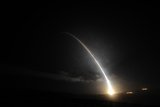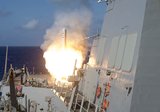3D-printed component on Trident missile
A 3D-printed missile component, a connector backshell, has flown on three of Lockheed Martin's Trident II D5 fleet ballistic missiles during US Navy testing, the company announced on 18 March.
The connector backshell is made of aluminium alloy, measures around an inch and protects cable connectors in the missile. Lockheed Martin used fully-digital processes to design and fabricate the connector backshell in half the time of traditional methods.
In the tests - part of a Follow-on Commander’s Evaluation Test of the Trident Strategic Weapon System - the navy launched the unarmed missiles in the Atlantic Ocean from a submerged submarine. The missiles were converted into test configurations using kits produced by Lockheed Martin that contain range safety devices and flight telemetry instrumentation.
Eric Scherff, vice president of fleet ballistic missile programs, Lockheed Martin Space Systems, said: ‘These tests demonstrate the readiness and reliability of this crucial system that protects what matters most for the nation. The Trident strategic weapon system stands guard every minute of every day, thanks to the dedication and forward thinking of the US Navy program office, the submarine crews and the industry team.’
The Trident II D5 missile is deployed aboard US Navy Ohio-class and UK Royal Navy Vanguard-class submarines to deter nuclear aggression. The three-stage ballistic missile can travel a nominal range of 4,000 nautical miles and carry multiple independently targeted reentry bodies.
More from Defence Notes
-
![US accuses Russia of using banned chemical weapons in Ukraine]()
US accuses Russia of using banned chemical weapons in Ukraine
Moscow was blamed for perpetrating multiple gas attacks with a choking agent against Kyiv’s armed forces.
-
![How UAE defence giant EDGE Group plans to double its exports]()
How UAE defence giant EDGE Group plans to double its exports
The UAE defence conglomerate has put an aggressive strategy in place to increase its share of exports while navigating the growing gap between East and West.
-
![US lawmakers warn that “more military spending is absolutely necessary” to ensure Pentagon’s readiness]()
US lawmakers warn that “more military spending is absolutely necessary” to ensure Pentagon’s readiness
The US Congress has raised concerns about how inflation rates and cuts in main acquisition programmes could affect the US military.
-
![Can the US overcome Russian and Chinese nuclear capabilities?]()
Can the US overcome Russian and Chinese nuclear capabilities?
Washington’s ageing inventory and the pace Moscow and Beijing have been modernising their capabilities put in check the US Nuclear deterrence.
-
![US FY2024 funding package passes as China closes military capability gap]()
US FY2024 funding package passes as China closes military capability gap
The Pentagon has been operating under temporary funding since October 2023, which has impacted its main acquisition and development programmes, increasing the capability gap between the US and China.
-
![NATO outlines future challenges as Ukrainian funding from US stalls]()
NATO outlines future challenges as Ukrainian funding from US stalls
In 2023, defence spending increased by an unprecedented 11% across European NATO countries and Canada. Since 2014, the group has spent an additional US$600 billion on defence.


























